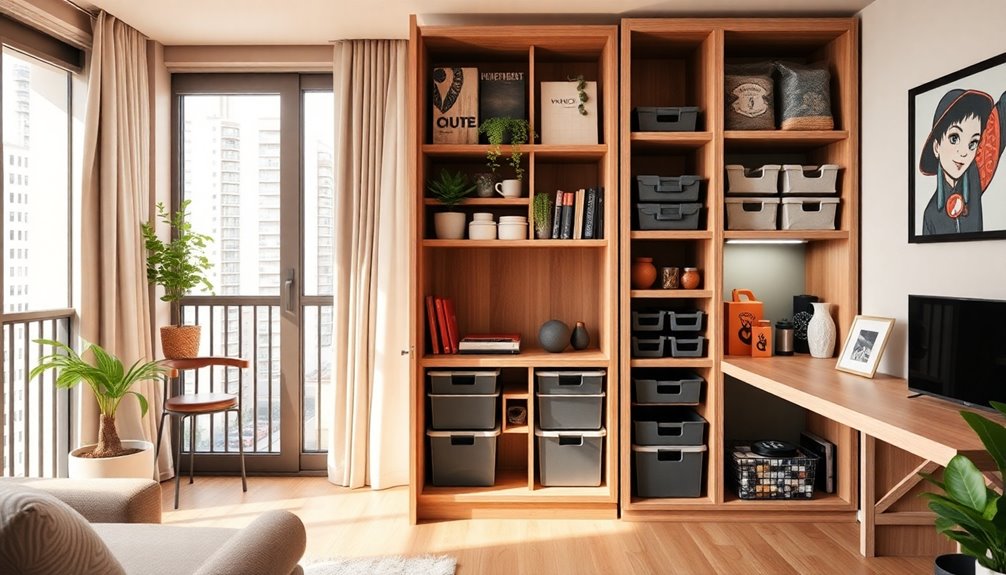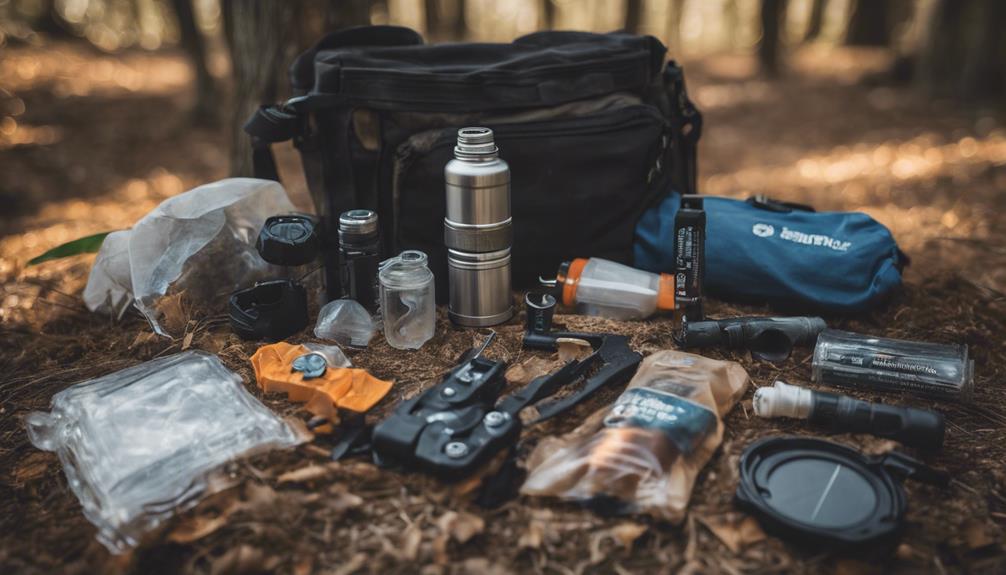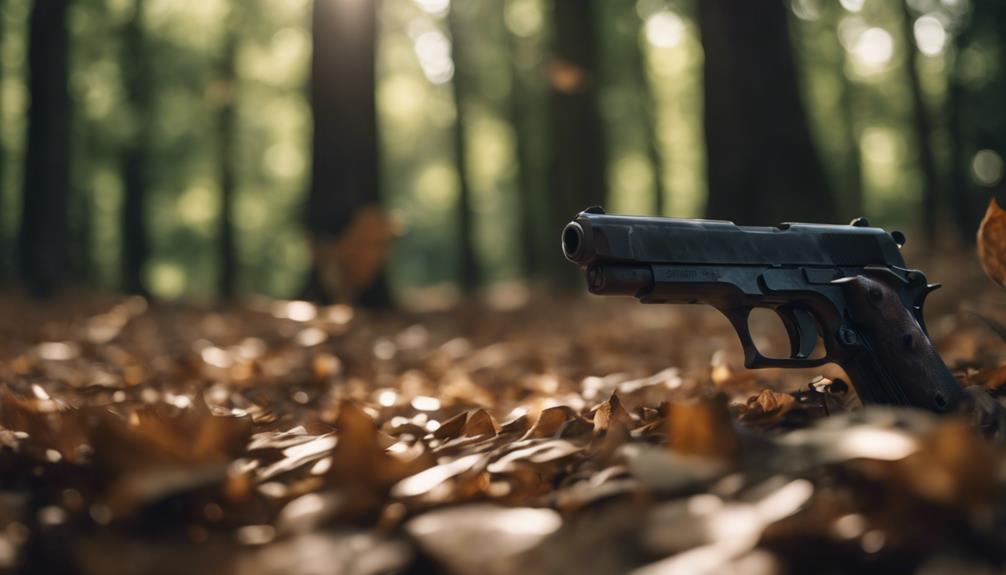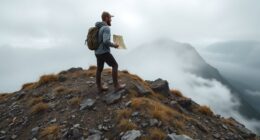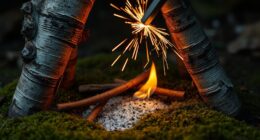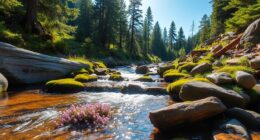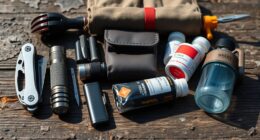To start a fire safely, choose a clear, open spot at least 15 feet away from tents and trees. Gather dry materials like bark, grass, or even dryer lint to use as tinder. Dig a 6-inch deep fire pit and line it with gravel. Build the fire structure using a teepee, log cabin, or lean-to design for good airflow. Light the tinder from the windward side and gently blow at the base to boost flames. Always keep water close to extinguish the fire when you're finished. There's more helpful information waiting for you to explore!
Key Takeaways
- Choose a safe location at least 15 feet away from tents, shrubs, and trees, ensuring it's open and level.
- Gather dry natural materials and everyday items for effective ignition, prioritizing highly flammable options.
- Prepare the fire pit by digging a 6-inch deep trench, filling it with gravel, and soaking the area with water.
- Build the fire structure using a teepee, log cabin, or lean-to design, ensuring good airflow and safety measures are in place.
- Light the tinder from the windward side, adding kindling gradually, and keep water nearby for extinguishing the fire.
Choosing a Safe Location

When you're choosing a safe location for your fire, make certain it's at least 15 feet away from tents, shrubs, trees, and low-hanging branches. This distance helps prevent any accidental ignitions from sparks or heat. Look for an open and level spot, as uneven ground can lead to unpredictable fire behavior. Before you set up, verify the area is clear of dry leaves, twigs, and other flammable materials that could easily catch fire.
It's also essential to select a location that's protected from gusts of wind, which can blow embers and cause the fire to spread. Whenever possible, use existing fire pits or rings, as they're designed to contain flames safely. Furthermore, practicing responsible fire management during your camping trip is crucial to ensure safety for everyone involved.
Before you start building your fire, check local regulations. Some areas have specific fire restrictions, especially during dry seasons or periods of high fire danger, and it’s critical to follow those rules. Being aware of local guidelines not only keeps you safe but also protects the environment. By taking these precautions when choosing your fire location, you set the stage for a safe and enjoyable campfire experience. Remember to choose a spot for your fire that is at least 15 feet away from tent walls, shrubs, trees, or other flammable items. Clear the area around your fire pit of any debris, and always keep a bucket of water or a hose nearby in case the fire spreads. These fire safety tips are essential for a worry-free camping experience and help to ensure that everyone can enjoy the great outdoors without putting themselves or the environment at risk.
Gathering Materials

Gathering the right materials is essential for building a safe and effective fire. You'll want to collect both natural and everyday items to guarantee your fire ignites easily and burns well. Here's a quick reference to help you gather the right materials:
| Natural Materials | Everyday Items | Improvised Materials |
|---|---|---|
| Dry Bark | Dryer Lint | Charred Cloth |
| Pine Resin | Cotton Balls | Pencil Shavings |
| Dry Leaves | Newspaper | Waxed Cardboard |
| Twigs and Small Branches | Hand Sanitizer | Dried Orange Peel |
| Dry Grass | Steel Wool | Cotton String/Pad Soaked in Wax |
Start by looking for dry bark, pine resin, and dry leaves in your surroundings. These will serve as excellent tinder. You can also gather everyday items like dryer lint or newspaper from home to enhance your fire-starting efforts. If you're feeling creative, consider using improvised materials such as charred cloth or pencil shavings. Each of these options will help you build a fire that's not only effective but also safe. Remember, the right materials can make all the difference! Additionally, using highly flammable materials like dryer lint can significantly increase the chances of successfully igniting your fire.
Preparing the Fire Pit

Preparing the fire pit is essential to guaranteeing your fire burns safely and effectively. First, select a location at least 10 feet away from trees, homes, fences, or any other structures. Check the wind direction to prevent smoke from blowing toward open doors or windows, and make sure you're away from flammable materials. Don't forget to verify with local authorities that open fires are permitted in your area.
Next, mark the fire pit's circumference using a flat-bladed spade or string tied to a stake. Dig a trench around the marked area that's about 6 inches deep and as wide as the blocks you'll use for the wall. Fill this trench with gravel and compact it to create a stable base. If you're working with soil, spread bedding sand and level it before laying any blocks. To ensure fire safety, incorporate a layer of gravel for drainage and stability at the base of your fire pit.
For proper drainage, dig a hole in the center of the pit, filling it with gravel to prevent water accumulation. Finally, soak the area around the fire pit with water to reduce fire risks and keep a source of water nearby for emergencies. These steps will help guarantee a safe and enjoyable fire experience.
Building the Fire Structure

With the fire pit ready, it's time to build a structure that will guarantee your fire burns brightly and safely. You can choose from three effective designs: the teepee, log cabin, or lean-to.
For the teepee structure, drive a forked stick into the ground at a 45-degree angle above your tinder. Lean another stick into the fork and add slightly thinner sticks, ensuring balance on both sides while leaving an opening for a spark. The teepee design is a top choice among experts for fire building due to its quick assembly and ability to generate tall flames.
If you prefer the log cabin, place inch-thick fuel wood parallel to the tinder pile. Build a square base with thumb-thick wood and layer thin kindling across the center. Continue this pattern until you reach a seven-level structure, making sure there's space to insert a match.
For the lean-to, lay an arm-thick log as a windbreak, placing your tinder beside it. Lean kindling against the log at a right angle over the tinder, alternating between thin and thick pieces. Remember to leave gaps for airflow.
Whichever structure you choose, use dry wood, maintain good airflow, and always keep safety measures, like water or a fire extinguisher, nearby.
Igniting and Maintaining the Fire

Once you've built your fire structure, it's time to ignite your fire safely and effectively. Start by using a match, lighter, or firestarter to light your dry tinder—things like paper, dry leaves, or wood shavings work best. Light the tinder from the windward side to help the flames spread efficiently, guaranteeing you don't smother the fire. It's also important to understand that fire safety practices must be followed to prevent accidents. Primitive weapons can also serve as a useful tool for gathering firewood in a survival situation.
Here are some tips for maintaining your flame:
- Gently blow on the base of the fire to provide oxygen as it grows.
- Add kindling gradually, arranging it for good airflow.
- Keep the fire small and manageable to prevent it from getting out of control.
As your kindling catches, begin adding larger pieces of dry fuel, like logs, in a teepee or pyramid shape to promote airflow. Avoid piling them too tightly, as this can suffocate your fire. Remember to monitor the fire and adjust its shape if necessary to maintain efficient burning. Always keep a source of water nearby to extinguish the fire when you're done. Following these steps will help guarantee a safe and enjoyable fire experience.
Frequently Asked Questions
What Should I Do if It Rains While Camping?
If it rains while you're camping, don't panic! First, check your gear for leaks and make sure you're dry. Then, find a sheltered spot to set up your tarp or tent. Gather any wet wood and try to dry it out, or use dry tinder if you have it. Keep your fire area clear of debris, and remember to monitor the fire closely to prevent it from smoldering out. Stay safe and enjoy your adventure!
Can I Use Lighter Fluid to Start My Fire?
Using lighter fluid to start your fire might seem tempting, but think twice. You're inviting toxic fumes, explosive risks, and potential burns into your space. Instead of relying on volatile chemicals, consider safer alternatives like charcoal chimney starters or natural fire starters. You'll enjoy a cozy fire without the health hazards or environmental impact. Plus, your gatherings will be safer, keeping everyone—especially kids—out of harm's way while you enjoy the flames.
What Are the Best Types of Wood for Burning?
When you're picking wood for burning, go for dense hardwoods like oak, maple, and hickory. They burn hotter and longer, giving you steady heat. Ash is a great choice too, as it burns well even when green. If you want a pleasant aroma, cherry adds a nice scent when properly seasoned. Avoid softwoods like pine and spruce, as they create excessive smoke and creosote, which can be hazardous. Happy burning!
How Can I Safely Cook Over My Campfire?
To safely cook over your campfire, use dry, seasoned wood for a clean burn. Set up a grill grate or a stable stick to hold your food at a safe distance from the flames. Keep your flame a couple of inches high for frying, and use roasting forks longer than 24 inches to avoid burns. Always supervise children near the fire, and make certain food is cooked thoroughly to prevent foodborne illnesses.
What Should I Do in Case of a Wildfire Warning?
If you receive a wildfire warning, act quickly. Stay informed by checking local alerts and updates. Gather your emergency kit, making certain you have essentials like water and important documents. Make sure your vehicle's fueled and ready to go. Close all windows and doors but leave them accessible. Follow evacuation routes and avoid heavy smoke. Finally, practice your evacuation plan with your family and pets to guarantee everyone knows what to do.
Conclusion
As the flames dance and crackle, casting a warm glow against the twilight sky, you've transformed your safe space into a cozy haven. With the right location, carefully gathered materials, and a well-structured fire, you've created not just warmth, but memories. So, sit back, breathe in the smoky scent, and let the flickering light invite stories and laughter. You've mastered the art of fire, igniting not just wood, but the spirit of adventure in every gathering.



